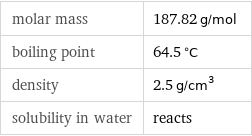Input interpretation

carbonyl bromide
Chemical names and formulas

formula | COBr_2 Hill formula | Br_2CO name | carbonyl bromide mass fractions | Br (bromine) 85.1% | C (carbon) 6.4% | O (oxygen) 8.52%
Lewis structure

Draw the Lewis structure of carbonyl bromide. Start by drawing the overall structure of the molecule, ignoring potential double and triple bonds: Count the total valence electrons of the bromine (n_Br, val = 7), carbon (n_C, val = 4), and oxygen (n_O, val = 6) atoms: 2 n_Br, val + n_C, val + n_O, val = 24 Calculate the number of electrons needed to completely fill the valence shells for bromine (n_Br, full = 8), carbon (n_C, full = 8), and oxygen (n_O, full = 8): 2 n_Br, full + n_C, full + n_O, full = 32 Subtracting these two numbers shows that 32 - 24 = 8 bonding electrons are needed. Each bond has two electrons, so in addition to the 3 bonds already present in the diagram add 1 bond. To minimize formal charge carbon wants 4 bonds and oxygen wants 2 bonds. Identify the atoms that want additional bonds and the number of electrons remaining on each atom: Fill in the 1 bond by pairing electrons between adjacent highlighted atoms: Answer: | |
Basic properties

molar mass | 187.82 g/mol boiling point | 64.5 °C density | 2.5 g/cm^3 solubility in water | reacts
Units

Chemical identifiers

CAS number | 593-95-3 SMILES identifier | C(=O)(Br)Br